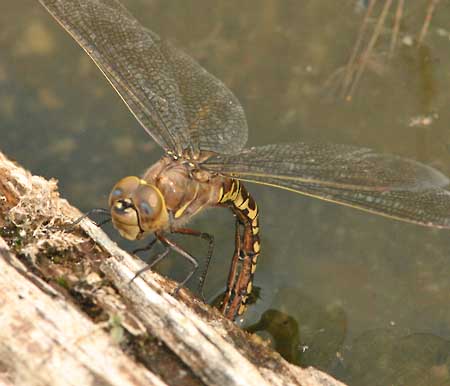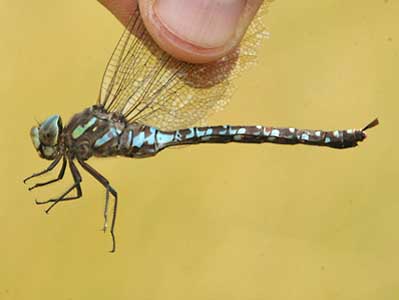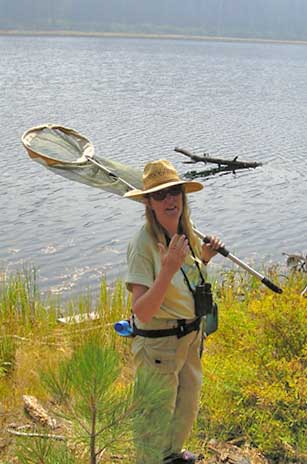| |
|
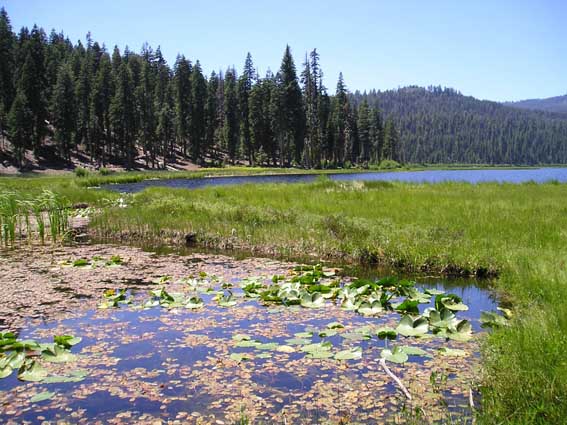 Willow Lake is one of the
most unusual lakes in California. It is ringed by a floating sphagnum
bog, and is justly famous among odites. Located ~9 miles northwest of
Chester, Plumas County, and within a mile of the
southern border of Lassen National Park, it is a cold montane lake at
5315' elevation. Along much of the perimeter of the lake is an
extensive sphagnum bog. Such bogs are very acidic.
Carnivorous plants have adapted to these conditions by using insects as
a nutrient source. While widespread at higher latitudes in both the
northern and southern hemispheres, such bogs are very rare in
California. Indeed, it was these unique qualities that first tempted
Tim Manolis to look for dragonflies there in 1998. Willow Lake is one of the
most unusual lakes in California. It is ringed by a floating sphagnum
bog, and is justly famous among odites. Located ~9 miles northwest of
Chester, Plumas County, and within a mile of the
southern border of Lassen National Park, it is a cold montane lake at
5315' elevation. Along much of the perimeter of the lake is an
extensive sphagnum bog. Such bogs are very acidic.
Carnivorous plants have adapted to these conditions by using insects as
a nutrient source. While widespread at higher latitudes in both the
northern and southern hemispheres, such bogs are very rare in
California. Indeed, it was these unique qualities that first tempted
Tim Manolis to look for dragonflies there in 1998.
In the top photo (above), Rita is walking out on
the floating bog. The spongy mat is cratered with cold pools. One sinks
with every step and it feels like walking on a gigantic waterbed. We
used rubber boots for the experience; it is impossible to stay dry
while walking on a sphagnum bog. The eerie experience is quite
beautiful, and a special delight.
According to Internet sources, the rare sundew Drosera
rotundifolia is found here, and Kalmia polifolia var. microphylla
(bog laurel) is abundant. The sign at the lake itself speaks of English
sundew Drosera anglica. Whatever the species may be (and
there may be several), the sundews (below left) are very impressive. I
also like this shot (right) of a young female Western Forktail sitting
among the dangerous and colorful plants.
|
|
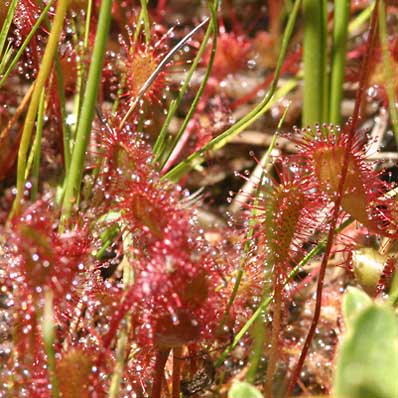
|
|
|
|

What makes Willow Lake famous in the odonate world is
that its unique environment supports several species that are otherwise
very rare or unknown within California. Sedge Sprite Nehalennia
irene (left, in tandem on 23 July) is regular only here and nearby
Cooper Swamp in Lassen County. Belted Whiteface Leucorrhinia
proxima and Autumn Meadowhawk Sympetrum vicinum were
discovered here in 1998 [I would miss both here in 2007]. Willow Lake
is one of only a handful of sites known for Canada Darner Aeshna
canadensis and Chalk-fronted Corporal Ladona
julia (below right from 7 July, the only one I saw in California
all year). The discovery of new State odes at Willow Lake was featured
in a paper by Tim Manolis & Andrew Rehn in 1999 (Argia
10:24–25).
Willow Lake remains the only locale known for Belted
Whiteface, where it was seen 1998 through 2005. None were reported in
2006-2007, and so I missed it. I did find Hudsonian Whiteface
L. hudsonica (below left) to be common here on 7
July.
|
|
|
|
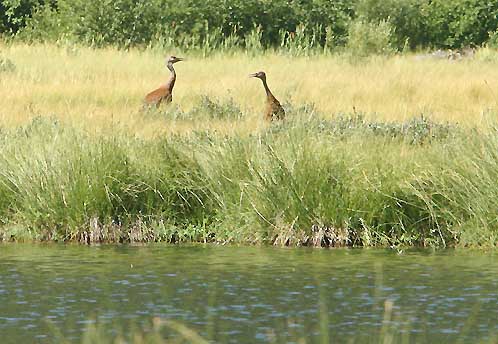 As Willow Lake is at the end of a 4.5 mile
dead-end rocky dirt road, visitors are comparatively few (although the
campground at road's edge and lake's edge can be filled up on weekend
nights in mid-summer). The back side of the lake, where these Sandhill
Cranes were on 23 July (right), is even quieter. There the sphagnum bog
is drier and heavily covered with grasses. As Willow Lake is at the end of a 4.5 mile
dead-end rocky dirt road, visitors are comparatively few (although the
campground at road's edge and lake's edge can be filled up on weekend
nights in mid-summer). The back side of the lake, where these Sandhill
Cranes were on 23 July (right), is even quieter. There the sphagnum bog
is drier and heavily covered with grasses.
As summer winds down, darners appear in good numbers
over the lake. At least five species are regular in August-September
(Common Green and four Aeshna), and identification can be
very challenging at lake's edge as one stands on the quaking bog. I
spent a lot of time during the weekend of 8-9 Sep attempting to take
digital photos of darners in flight over the lake's edge. Many shots
were worthless, but others showed distant darners (below) that, when
enlarged on my home computer, could be identified. This one actually
proved to be a Canada Darner on 8 Sep, a species that
I thought I'd missed by that day's end. As it turned out, I actually
ended up with photos of all the species this way.
|
|
|
|
The most common Aeshna darners were Variable
(right; a female ovipositing) and Paddle-tailed
(below; a male in flight). During the weekend of 8-9 Sep, I found
perched males of both species.
Paddle-tailed Darner proved to have an interesting
distribution at Willow Lake. While Variable, Shadow, and Canada were
invariably found out at or near the edge of the lake, Paddle-tailed
frequented the cool creeks and pools within the sphagnum bog and was
much less frequent at the lakeshore. At these internal creeks and
pools, it seemed to be the only darner present. Its behavior was also
different, with males often hovering motionless for substantial periods
(i.e., 20 seconds), permitting better flight shots (as below).
|
|
|
|
|
|
|
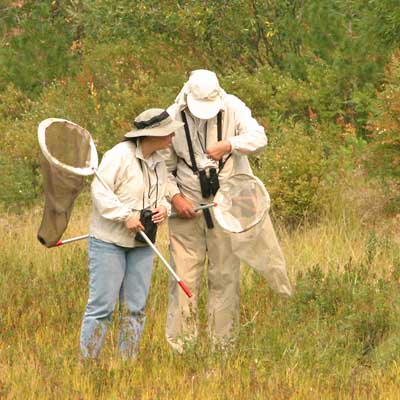 One way to study and identify darners is to
net them, examine them, and release them unharmed. On my visit of 9 Sep
2007, Ray Bruun (above) and Joe Smith
(left; Jenn Tiehm checks out the catch) were particularly adept with
the net. While my modest efforts obtained in-hand view of common
darners (Paddle-tailed, Variable), these two wizards caught a male Shadow
Darner (below left) and a female Canada Darner
(below right). The latter, snagged by Ray as she was apparently
attempting to oviposit in the wet grass, was particularly gratifying
because it was my first 'sure' Canada after 11 hours of bog-slogging
that weekend (I did not know at the time I actually had photographed a
distant Canada in flight). The female Canada's appendages were worn,
and one was entirely broken off, as is often typical of this and other Aeshna
species. Shadow & Canada are the only darners in California with
blue spots on the underside of the abdomen; Canada has a 'Dutch shoe'
shape to the anterior thoracic stripe. One way to study and identify darners is to
net them, examine them, and release them unharmed. On my visit of 9 Sep
2007, Ray Bruun (above) and Joe Smith
(left; Jenn Tiehm checks out the catch) were particularly adept with
the net. While my modest efforts obtained in-hand view of common
darners (Paddle-tailed, Variable), these two wizards caught a male Shadow
Darner (below left) and a female Canada Darner
(below right). The latter, snagged by Ray as she was apparently
attempting to oviposit in the wet grass, was particularly gratifying
because it was my first 'sure' Canada after 11 hours of bog-slogging
that weekend (I did not know at the time I actually had photographed a
distant Canada in flight). The female Canada's appendages were worn,
and one was entirely broken off, as is often typical of this and other Aeshna
species. Shadow & Canada are the only darners in California with
blue spots on the underside of the abdomen; Canada has a 'Dutch shoe'
shape to the anterior thoracic stripe. |
|
|
|
A species list for Willow Lake in 1998 has been
published (Manolis & Rehn 1999; 30 species). My own combined list
during 3 visits in 2007 had the following odonates:
Northern Spreadwing (Sep)
Spotted Spreadwing (R Bruun in Sep)
Vivid Dancer (July–Sep)
Pacific Forktail (July–Sep)
Western Forktail (July–Sep)
Boreal Bluet (some; netted in Sep)
Northern Bluet (common in July)
Familiar Bluet (1 in Sep)
Sedge Sprite (both July visits)
Western Red Damsel (a few in July)
C. Green Darner (common in Sep)
Canada Darner (2 in Sep)
Variable Darner (common in Sep)
Paddle-tailed Darner (July–Sep)
Shadow Darner (a few in Sep)
|
American Emerald (female
ovipositing 7 July, male seen 23 July)
Hudsonian Whiteface (common in early July)
Dot-tailed Whiteface (both July visits)
Variegated Meadowhawk (both July visits)
Black Meadowhawk (a few in Sep)
White-faced Meadowhawk (a few July, many Sep)
Western Meadowhawk (a few in Sep)
Striped Meadowhawk (a few July–Sep)
Chalk-fronted Corporal (1 in early July)
Four-spotted Skimmer (common in early July)
Eight-spotted Skimmer (a few in July by RC)
Twelve-spotted Skimmer (a few in July)
I was fortunate to have good company during most
of my visits. In July it was Rita Carratello. On 8 Sep I was alone but
on 9 Sep there were Ray Bruun, Joe Smith, Jenn Tiehm, and Dave &
Kathy Biggs (right).
The montage below (five photos combined) shows the
entire lake, looking east from the west side. It is from 9 Sep.
|
|
|
|
|
|
|

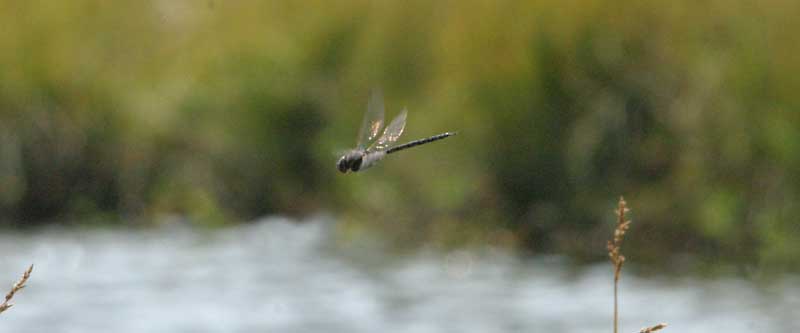
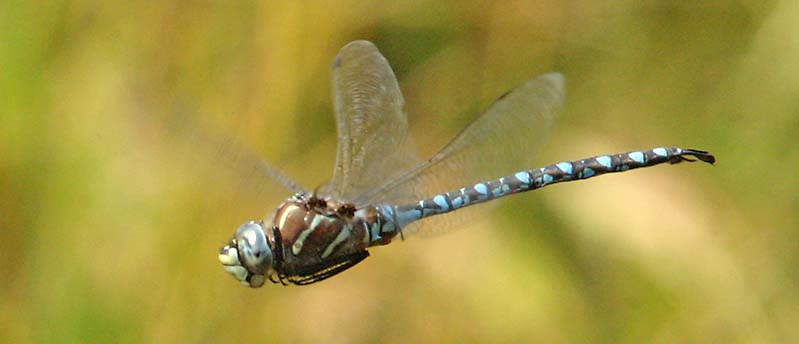

 One way to study and identify darners is to
net them, examine them, and release them unharmed. On my visit of 9 Sep
2007, Ray Bruun (above) and Joe Smith
(left; Jenn Tiehm checks out the catch) were particularly adept with
the net. While my modest efforts obtained in-hand view of common
darners (Paddle-tailed, Variable), these two wizards caught a male Shadow
Darner (below left) and a female Canada Darner
(below right). The latter, snagged by Ray as she was apparently
attempting to oviposit in the wet grass, was particularly gratifying
because it was my first 'sure' Canada after 11 hours of bog-slogging
that weekend (I did not know at the time I actually had photographed a
distant Canada in flight). The female Canada's appendages were worn,
and one was entirely broken off, as is often typical of this and other Aeshna
species. Shadow & Canada are the only darners in California with
blue spots on the underside of the abdomen; Canada has a 'Dutch shoe'
shape to the anterior thoracic stripe.
One way to study and identify darners is to
net them, examine them, and release them unharmed. On my visit of 9 Sep
2007, Ray Bruun (above) and Joe Smith
(left; Jenn Tiehm checks out the catch) were particularly adept with
the net. While my modest efforts obtained in-hand view of common
darners (Paddle-tailed, Variable), these two wizards caught a male Shadow
Darner (below left) and a female Canada Darner
(below right). The latter, snagged by Ray as she was apparently
attempting to oviposit in the wet grass, was particularly gratifying
because it was my first 'sure' Canada after 11 hours of bog-slogging
that weekend (I did not know at the time I actually had photographed a
distant Canada in flight). The female Canada's appendages were worn,
and one was entirely broken off, as is often typical of this and other Aeshna
species. Shadow & Canada are the only darners in California with
blue spots on the underside of the abdomen; Canada has a 'Dutch shoe'
shape to the anterior thoracic stripe. 
 Willow Lake is one of the
most unusual lakes in California. It is ringed by a floating sphagnum
bog, and is justly famous among odites. Located ~9 miles northwest of
Chester, Plumas County, and within a mile of the
southern border of Lassen National Park, it is a cold montane lake at
5315' elevation. Along much of the perimeter of the lake is an
extensive sphagnum bog. Such bogs are very acidic.
Carnivorous plants have adapted to these conditions by using insects as
a nutrient source. While widespread at higher latitudes in both the
northern and southern hemispheres, such bogs are very rare in
California. Indeed, it was these unique qualities that first tempted
Tim Manolis to look for dragonflies there in 1998.
Willow Lake is one of the
most unusual lakes in California. It is ringed by a floating sphagnum
bog, and is justly famous among odites. Located ~9 miles northwest of
Chester, Plumas County, and within a mile of the
southern border of Lassen National Park, it is a cold montane lake at
5315' elevation. Along much of the perimeter of the lake is an
extensive sphagnum bog. Such bogs are very acidic.
Carnivorous plants have adapted to these conditions by using insects as
a nutrient source. While widespread at higher latitudes in both the
northern and southern hemispheres, such bogs are very rare in
California. Indeed, it was these unique qualities that first tempted
Tim Manolis to look for dragonflies there in 1998. 
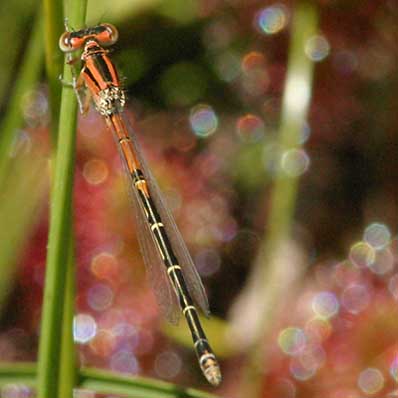
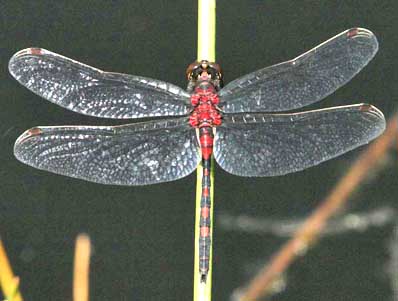
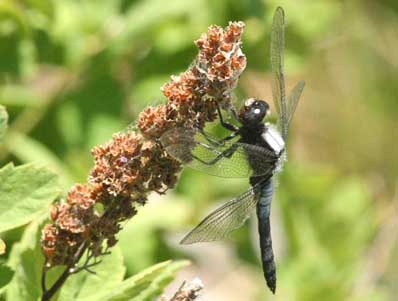
 As Willow Lake is at the end of a 4.5 mile
dead-end rocky dirt road, visitors are comparatively few (although the
campground at road's edge and lake's edge can be filled up on weekend
nights in mid-summer). The back side of the lake, where these Sandhill
Cranes were on 23 July (right), is even quieter. There the sphagnum bog
is drier and heavily covered with grasses.
As Willow Lake is at the end of a 4.5 mile
dead-end rocky dirt road, visitors are comparatively few (although the
campground at road's edge and lake's edge can be filled up on weekend
nights in mid-summer). The back side of the lake, where these Sandhill
Cranes were on 23 July (right), is even quieter. There the sphagnum bog
is drier and heavily covered with grasses.